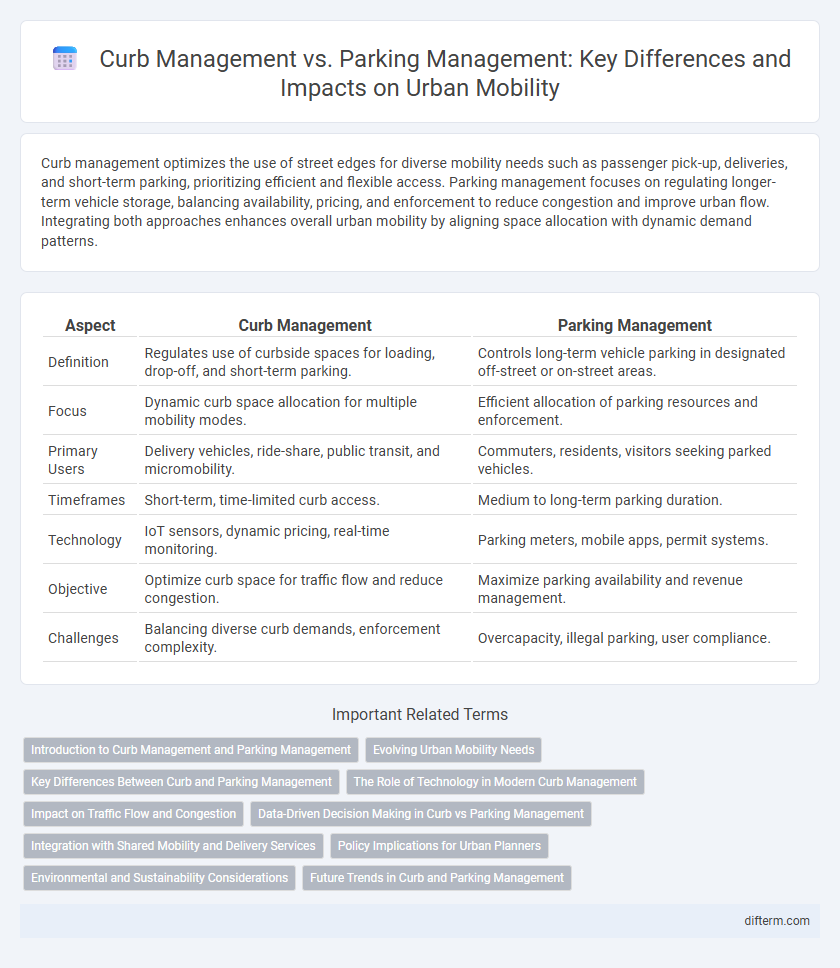Curb management optimizes the use of street edges for diverse mobility needs such as passenger pick-up, deliveries, and short-term parking, prioritizing efficient and flexible access. Parking management focuses on regulating longer-term vehicle storage, balancing availability, pricing, and enforcement to reduce congestion and improve urban flow. Integrating both approaches enhances overall urban mobility by aligning space allocation with dynamic demand patterns.
Table of Comparison
| Aspect | Curb Management | Parking Management |
|---|---|---|
| Definition | Regulates use of curbside spaces for loading, drop-off, and short-term parking. | Controls long-term vehicle parking in designated off-street or on-street areas. |
| Focus | Dynamic curb space allocation for multiple mobility modes. | Efficient allocation of parking resources and enforcement. |
| Primary Users | Delivery vehicles, ride-share, public transit, and micromobility. | Commuters, residents, visitors seeking parked vehicles. |
| Timeframes | Short-term, time-limited curb access. | Medium to long-term parking duration. |
| Technology | IoT sensors, dynamic pricing, real-time monitoring. | Parking meters, mobile apps, permit systems. |
| Objective | Optimize curb space for traffic flow and reduce congestion. | Maximize parking availability and revenue management. |
| Challenges | Balancing diverse curb demands, enforcement complexity. | Overcapacity, illegal parking, user compliance. |
Introduction to Curb Management and Parking Management
Curb management optimizes the use of street edges for multiple functions such as loading zones, pick-up/drop-off areas, and short-term stops to enhance urban mobility and reduce congestion. Parking management focuses on regulating on-street and off-street parking spaces through pricing, enforcement, and technology to maximize availability and turnover. Efficient integration of curb and parking management strategies supports sustainable transportation systems and improves traffic flow in dense urban environments.
Evolving Urban Mobility Needs
Effective curb management addresses dynamic urban demands by optimizing space for diverse uses such as ride-sharing, deliveries, and micromobility, surpassing traditional parking management's static allocation of spots. Real-time data integration and adaptive policies enhance curb utilization, reducing traffic congestion and supporting sustainable mobility modes. Prioritizing curb space flexibility aligns with evolving urban mobility trends demanding efficient, multimodal infrastructure solutions.
Key Differences Between Curb and Parking Management
Curb management prioritizes optimizing short-term access and efficient use of limited curb space for loading, unloading, and passenger pick-up/drop-off, while parking management focuses on allocating long-term vehicle storage and regulating parking durations. Curb management integrates dynamic pricing, real-time data, and multimodal transportation needs, contrasting with parking management's emphasis on fixed zones, permit systems, and enforcement strategies. Effective curb management supports urban mobility by reducing congestion and enhancing accessibility, whereas parking management primarily addresses vehicle storage and compliance within designated areas.
The Role of Technology in Modern Curb Management
Modern curb management leverages real-time data analytics, IoT sensors, and AI-driven platforms to optimize curb space allocation, enhance traffic flow, and reduce congestion more efficiently than traditional parking management systems. Advanced technologies enable dynamic curb usage policies, such as time-based restrictions and dedicated zones for ride-sharing, delivery vehicles, and micromobility options. This digital transformation in curb management supports urban mobility goals by improving accessibility, safety, and environmental sustainability.
Impact on Traffic Flow and Congestion
Curb management optimizes loading zones, passenger pick-up, and drop-off areas, significantly reducing double parking and improving traffic flow in urban environments. In contrast, traditional parking management primarily regulates vehicle storage, often leading to increased congestion as drivers search for available spaces. Effective curb management strategies can decrease traffic bottlenecks and enhance overall mobility by streamlining short-term uses critical to dynamic city streets.
Data-Driven Decision Making in Curb vs Parking Management
Data-driven decision making in curb management leverages real-time sensor data and mobility analytics to optimize space allocation for dynamic uses such as loading zones and ride-share pickups. In contrast, parking management relies heavily on historical occupancy data and payment patterns to improve long-term parking availability and revenue models. Integrating IoT and AI technologies enhances both systems by enabling adaptive responses to urban traffic flow and reducing congestion.
Integration with Shared Mobility and Delivery Services
Curb management integrates dynamically with shared mobility and delivery services by allocating specific zones for ride-hailing, bike-share docking, and parcel loading, optimizing urban space usage. Efficient curb management systems leverage real-time data and IoT sensors to adjust curb allocations based on demand patterns, enhancing traffic flow and reducing congestion compared to traditional parking management. This adaptive approach supports the seamless operation of shared mobility fleets and last-mile deliveries, improving overall city mobility and sustainability.
Policy Implications for Urban Planners
Curb management prioritizes efficient use of limited urban curb space for multiple functions such as loading, ride-share, and short-term parking, requiring dynamic policies that adapt to real-time demand and reduce congestion. Urban planners must integrate smart technologies and flexible regulations to balance competing uses while promoting sustainable mobility and equitable access. Effective curb policies can improve traffic flow, support public transit, and enhance pedestrian safety more comprehensively than traditional parking management approaches.
Environmental and Sustainability Considerations
Effective curb management reduces vehicle idling and congestion by optimizing short-term stops for loading and ride-hailing, which decreases emissions and improves air quality compared to traditional parking management that often encourages longer vehicle dwell times and inefficient space use. Incorporating dynamic curb pricing and real-time data analytics supports sustainable urban mobility by promoting shared and multimodal transportation options, reducing the carbon footprint associated with private car usage. Prioritizing curb space for electric vehicle charging and micro-mobility hubs further enhances environmental benefits by facilitating cleaner transportation modes and reducing reliance on fossil fuels.
Future Trends in Curb and Parking Management
Future trends in curb and parking management emphasize dynamic, data-driven solutions integrating real-time analytics and IoT sensors to optimize space utilization and reduce congestion. Smart curb management prioritizes multimodal access, accommodating deliveries, rideshares, and micromobility, while advanced parking management leverages AI for demand forecasting and automated payment systems. The convergence of autonomous vehicle technology and connected infrastructure will further transform curb and parking operations, enhancing urban mobility efficiency and sustainability.
curb management vs parking management Infographic

 difterm.com
difterm.com